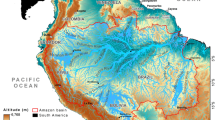Abstract
The arrival of migratory shorebirds on beaches in urban communities in developing countries is a current challenge for the protection of these migrant birds. Nearctic-Neotropical migrants rely on roosting and feeding sites during their stopover on wintering sites in the Southern Hemisphere to acquire sufficient energy to complete their migratory cycles. On the other hand, cities in the Southern Hemisphere are growing rapidly, which results in increasing competition for space between humans and birds, such as for use in beach habitats. In the present study, I analyze the probability for occurrence for Nearctic-Neotropical migratory birds relative to the number of people in southeastern Brazil, the most populated region of South America. The frequency of occurrence of migrants, their distance of tolerance to people and the number of people were recorded in sample areas (circle plots with 20 m radius) on a 9 km stretch of urban beaches from November to February from 2009 to 2013. The probability of occurrence of Nearctic birds decreased as the number of people increased. When the number of people exceeded 20, the probability of occurrence of birds was almost zero. Furthermore, more than 95 % of birds moved off when people were within 16 m of reach. These results are discussed in the context of conservation actions since no management plan has been developed for migrant shorebirds that use urban beaches as stopover or wintering sites in developing countries.



Similar content being viewed by others
References
Antas PTZ (1984) Migration of Nearctic shorebirds (Charadriidae and Scolopacidae) in Brasil: flyways and their different seasonal use. Wader Stud Group Bull 39:52–56
Barbieri E, Mendonça JT (2006) Distribution and abundance of Charadriidae at Ilha Comprida, São Paulo State, Brazil. J Coast Res 21:1–10
Burger J (1981) The effect of human activity on birds at a coastal bay. Biol Conserv 21:231–241
Burger J (1993) Shorebird squeeze. Nat Hist 102:8–12
Burger J, Gochfeld M (1991) Human influence and diurnal and nocturnal foraging of sanderlings (Calidris alba). Condor 93:259–265
Burger J, Niles LJ (2012) Shorebirds and stakeholders: effects of beach closure and human activities on shorebirds at a New Jersey coastal beach. Urban Ecosyst 5:50–62
Burger J, Jeitner C, Clark K, Niles LJ (2004) The effects of human activities on migrant shorebirds: successful adaptive management. Environ Conserv 31:283–288
Burton NHK, Rehfisch MM, Clark NA, Dodd SG (2006) Impacts of sudden winter habitat loss on the body condition and survival of Redshank Tringa totanus. J Appl Ecol 43:464–473
Cestari C (2008) O uso de praias arenosas com diferentes concentrações humanas por espécies de aves limícolas (Charadriidae e Scolopacidae) neárticas no sudeste do Brasil. Biota Neotrop 8:83–88
Cestari C (2009) Heterospecific sociality of birds on beaches from southeastern Brazil. Zoologia 26:594–600
Cestari C (2011) Foraging behavior of Hudsonian Godwit Limosa haemastica (Charadriiformes, Scolopacidae) in human-disturbed and undisturbed occasions in the Atlantic coast of Brazil. Rev Bras Ornitol 19:535–538
Gill JA (2007) Approaches to measuring the effects of human disturbances on birds. Ibis 149(Suppl 1):9–14
IBGE (2014) Diretoria de Pesquisas do Instituto Brasileiro de Geografia e Estatísticas. Coordenação de população e indicadores populacionais. http://www.ibge.gov.br/home/estatistica/populacao/estimativa2012/estimativa_tcu.shtm. Accessed 23 Apr 2014
Malik K (2013) Human development report. The rise of the South: human progress in a diverse world. United Nations Development Programme. http://hdr.undp.org/en/reports/global/hdr2013/download/. Accessed 20 Sept 2013
Morrison RIG (2004) Declines in wintering populations of red knots in southern South America. Condor 106:60–70
Pfister C, Harrington BA, Lavine M (1992) The impact of human disturbance on shorebirds at a migration staging area. Biol Conserv 60:115–126
Skagen KS (2006) Migration stopovers and the conservation of Arctic-breeding Calidridine sandpipers. Auk 123:313–322
Sutherland WJ (2007) Future directions in disturbance research. Ibis 149(Suppl 1):120–124
Tarifa JR (2004) Unidades climáticas dos maciços litorâneos da Juréia-Itatins. In: Marques OAV, Duleba W (eds) Estação Ecológica Juréia-Itatins: ambiente físico, flora e fauna. Holos Press, Ribeirão Preto, pp 42–50
Thomas K, Kvitek RG, Bretz C (2003) Effects of human activity on the foraging behavior of the sanderlings Calidris alba. Biol Conserv 109:67–71
Valente RM, Silva JMC, Straube FC, Nascimento JLX (2011) Conservação de aves migratórias Neárticas no Brasil. Conservação Internacional, Belém
Vooren CM, Chiaradia A (1990) Seasonal abundance and behavior of coastal birds on Cassino beach, Brazil. Ornitol Neotrop 1:9–22
Acknowledgments
I’m grateful for comments of two anonymous reviewers. Helpful suggestions were provided by Bette Loiselle and Alex Jahn. This research was supported by National Counsel of Technological and Scientific Development (grant 140625/2009-7).
Author information
Authors and Affiliations
Corresponding author
Rights and permissions
About this article
Cite this article
Cestari, C. Coexistence between Nearctic-Neotropical migratory shorebirds and humans on urban beaches of the Southern Hemisphere: a current conservation challenge in developing countries. Urban Ecosyst 18, 285–291 (2015). https://doi.org/10.1007/s11252-014-0399-3
Published:
Issue Date:
DOI: https://doi.org/10.1007/s11252-014-0399-3




